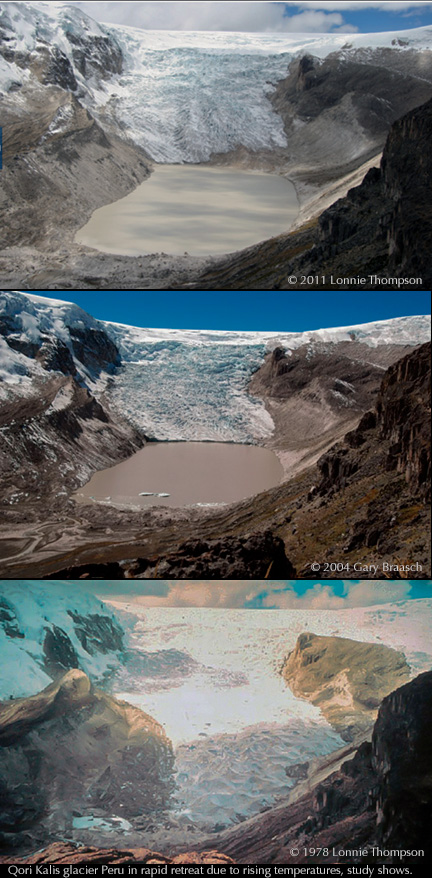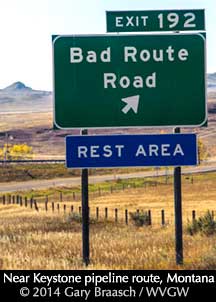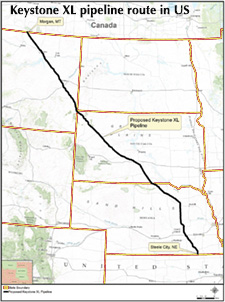Climate Photo of the Week
NEW! Image Galleries
Rapidly shrinking tropical glacier in Andes is affected mostly by rising temperatures rather than precipitation.

A new study adds to the scientific understanding that glaciers on all continents and all mountain ranges are more strongly affected by rising atmospheric temperature than by other factors. Measurements show all but a few mountain glaciers are rapidly retreating, losing mass or area, and the evidence is clear for most of them that rising air temperature from global warming is the main reason. Scientific discussion persists about tropical glaciers like those in the Andes and on Kilimanjaro in Africa, with some glaciologists more convinced that precipitation changes or solar radiation are the main factors. Snowfall and ice loss by sublimation could be caused by factors other than global warming. A study of moraines pushed up by a fluctuating high altitude glacier in Peru builds a strong case that the glacier has been retreating even while its source ice field accumulated snowfall. Sometimes in past centuries the reverse was true: The glacier, Qori Kalis, advanced in step with slightly cooler temperatures even when ice accumulation was less. Thus the scientists of the new study published in Geology journal "suggest that temperature, rather than net accumulation, was the primary driver of these glacial fluctuations." Data on the ice accumulation of the source of Qori Kalis glacier, Quelccaya Ice Cap, largest tropical ice field, was provided by glaciologist Lonnie Thompson, who has been making ice core studies there since the 1970s. In 2013, Thompson and his colleagues reported in Science journal that the Quelccaya ice field is not only smaller than it was 6000 years ago, but that plant remains uncovered as the ice cap shrinks show that "the advance of the [icecap about] 6000 years ago was much slower, ~300 meters over ~1600 years, than its current rate of retreat, ~300 meters in 25 years." For more information, see the comprehensive article by Justin Gillis in the New York Times.
Is Keystone XL Pipeline needed on the road to American energy independence -- does it drive us toward more pollution and away from clean energy? Please see below.
The Keystone XL oil pipeline, proposed to carry greenhouse gas-intensive oil sands crude from Canada to U.S refineries, would increase global warming emissions, but not by a significant amount compared to burning other kinds of crude oil, according to an Environmental Impact Statement released by the U.S. State Department on January 31. The EIS concluded there was little additional environmental risk from the pipeline. In the long awaited report the State Department rejected the idea that not building the pipeline would stifle oil extraction from the Alberta tar sands, a major goal of environmental and climate action groups.

Environmental leaders continued to demand that the Keystone XL oil sands crude pipeline not be built, because of the extra level of emissions, pollution risks and the encouragement of demand for fossil fuels in the face of climate change. Threats include pipeline breaches, such as the Exxon pipeline rupture which polluted the Yellowstone River in 2011, and harm to fresh water in the 62 large rivers, lakes and wetlands which the pipe will cross. The 36-inch pipe will be buried about 5 feet deep along a 110 foot construction corridor, but will be tunneled deeper under major rivers like the Yellowstone and Missouri. It would connect to pipelines already built south from Kansas to Texas refineries. Environmental and climate action leaders pointed out that the EIS looks at the oil use in isolation, assuming it has to be used, giving almost no consideration of energy actions to cut back on fossil fuels. Phil Radford of Greenpeace said: “The idea that this pipeline would pose little environmental risk is laughable. If built it will transport the dirtiest fuel on the planet across six states and hundreds of waterways." California Senator Barbara Boxer expressed concern for the health of affected communities.

A final decision will be made by President Obama with advice from Secretary of State John Kerry, after a 90 day comment period by other agencies. The EPA, for example, was critical of the draft EIS in 2013. The President said in June 2013 that "our national interest will be served only if this project does not significantly exacerbate the problem of carbon pollution." And in his recent State of the Union address, he said that a cleaner energy economy "will require some tough choices along the way. But the debate is settled. Climate change is a fact."
The State Department study calculated that oil sands crude creates "an estimated 17 percent more GHGs on a lifecycle basis than the average barrel of crude oil refined in the United States." It said that American and international markets would continue a demand for the Canadian crude even without the Keystone pipeline. For other issues revealed in the report, including threats to water from oil leaks, see this NRDC blog.
This project would be impossible without scientists and observers around the world who have provided hundreds of scientific contacts and papers. See Background, Advisors, and Reference for documentation, funders and major advisors, without whom I could not complete the work.
World View of Global Warming is a project of the Blue Earth Alliance, Seattle Washington, a 501(c)3 tax-exempt organization. The project is supported entirely by donations, grants, and license fees for the photographs. Please see information about how to contribute.
For other information about Gary Braasch's climate change projects and books, please see the books Earth Under Fire and How We Know What We Know About Our Changing Climate, and the exhibit "Climate Change in Our World" at the Books and Exhibits link
COPYRIGHT NOTICE:
Photography and text Copyright © 2005 - 2017 (and before) Gary Braasch All rights reserved. Use of photographs in any manner without permission is prohibited by US copyright law. Photography is available for license to publications and other uses. Please contact requestinformation@worldviewofglobalwarming.org. View more of Gary Braasch's photography here.


